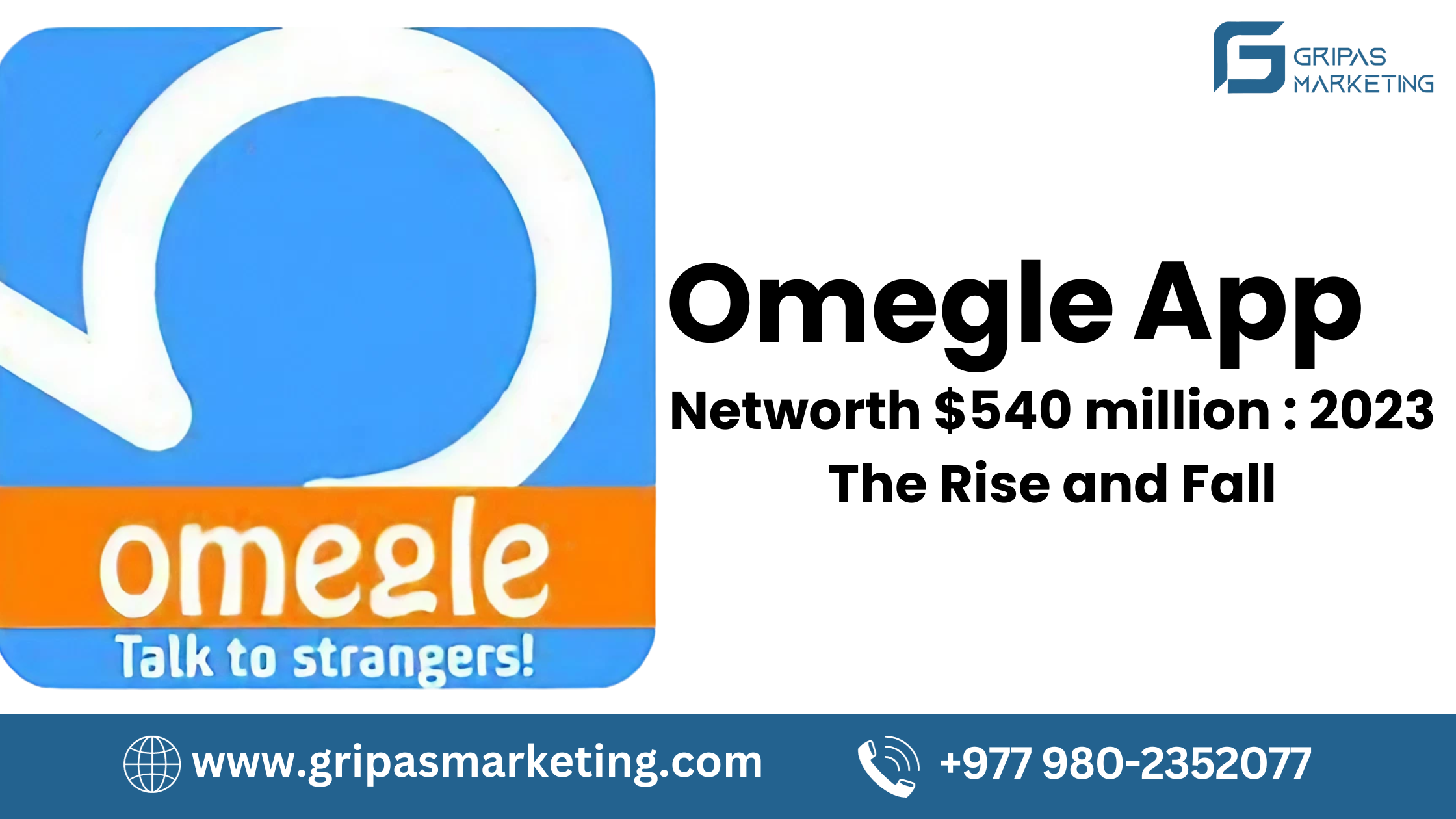Unveiling the Journey of the Pioneering Chat Platform Omegle’s Genesis
In 2009, a new concept emerged on the internet, forever changing the way people interacted online. This concept was Omegle, a platform that allowed users to engage in anonymous one-on-one chats with strangers. The idea was simple yet groundbreaking, as it provided a space for spontaneous and unfiltered conversations. This article takes you on a journey through the captivating rise and eventual fall of Omegle, from its humble beginnings to its recent and unexpected shutdown.The Rise and Fall of Omegle App.
Omegle Key Statistics 2023
- In total, Omegle active users are 23.5 million.
- Omegle’s net worth is estimated at $504 million.
- Omegle app revenue is estimated to be $216 million a year.
- As per Omegle user statistics, on average, Omegle had 69.3 million monthly visits in Q1 2023.
- According to Omegle traffic stats, most of its traffic, i.e. 41.99% comes from Reddit.
- Omegle daily users amount to 3.35 million active users.
- Omegle reviews are average with an overall rating of ⭐ 2.36/5.
- Which country uses Omegle the most: USA is on top with 29.93%.
- Omegle top alternatives include Chatous, Cleverbot, and Emerald.
The Rise and Fall of Omegle App-$540 million,2023
Omegle’s story begins with its founder, Leif K-Brooks, a visionary entrepreneur who wanted to redefine online communication. Leif envisioned a platform where people could engage in conversations with random individuals, free from the constraints of identity. The concept was rooted in the idea that anonymity could lead to more authentic and open interactions.
Leif K-Brooks was just 18 years old when he started developing Omegle. His journey was marked by late-night coding sessions, the pursuit of perfection, and the determination to create something unique. Omegle’s early days were filled with excitement and uncertainty, as Leif and his small team worked tirelessly to bring their vision to life.
The Meteoric Rise
Omegle’s launch marked the beginning of a digital revolution. It didn’t take long for the platform to gain widespread attention and millions of users. People from all around the world flocked to Omegle to experience the thrill of talking to strangers. The platform’s unfiltered and unpredictable nature made it a unique destination for those seeking genuine human connections.
One of the key factors that contributed to Omegle’s success was its simplicity. Users didn’t need to create an account or provide any personal information. They could jump right into conversations, making it a refreshing departure from the formalities of traditional social media.
Omegle became a cultural phenomenon, with users sharing stories of memorable encounters and forming friendships that transcended borders. Its popularity grew rapidly, and it seemed like the platform was destined for greatness.
Challenges and Controversies
However, The Rise and Fall of Omegle App journey was far from smooth. With its meteoric rise came a host of challenges and controversies that threatened its reputation and longevity. The lack of user identification led to inappropriate and explicit content being shared on the platform, causing concerns about the safety and well-being of its users.
Privacy issues were also a major concern. The anonymous nature of the platform made it a breeding ground for cyberbullying and harassment. Users faced unwanted exposure to explicit content and offensive behavior, and the need for effective moderation became evident.
Omegle struggled to strike a balance between maintaining the spontaneity of interactions and ensuring a safe and respectful environment. The platform introduced various features to combat these issues, such as a “report” button and keyword filters. However, these measures were not always sufficient to curb the problems that had arisen.
The Founder’s Struggle
Behind the scenes, Leif K-Brooks faced the psychological and financial toll of running a platform like Omegle. The constant need to moderate explicit content took a significant toll on him and his team. They were exposed to the worst of what the internet had to offer, and it weighed heavily on their minds.
The financial sustainability of Omegle also became a concern. Despite its massive user base, the platform struggled to monetize effectively. Leif’s commitment to keeping the platform free for users meant that generating revenue was a constant challenge. As hosting costs and legal issues mounted, the strain on the team and its founder increased.
The emotional and mental burden of dealing with the platform’s darker side took a toll on Leif personally. He found himself facing burnout and was often forced to confront the ethical implications of running a service that could be used for both good and ill.
The Changing Landscape
As time passed, the landscape of online interaction began to shift. Users started to demand safer and more moderated platforms where they could engage in conversations without the fear of encountering explicit content or harassment. This posed a significant challenge for Omegle, which had built its identity on anonymity and spontaneity.
Omegle responded by implementing various changes and enhancements aimed at improving the user experience. The introduction of optional sign-ups and more robust moderation tools was an attempt to make the platform safer and more enjoyable for its users. However, these changes came with their own set of challenges, including the risk of compromising the very essence of Omegle’s initial concept.
The evolving landscape of online communication puts Omegle in a difficult position. It had to adapt to meet the changing demands of its users while still retaining the essence of what made it unique.
Nostalgia and Farewells
Then, in an unexpected turn of events, the news broke that Omegle was shutting down after 14 years of operation. The platform that had left an indelible mark on the online world was closing its doors, leaving its users in a state of nostalgia and reflection.
Social media platforms were flooded with memories and stories of Omegle encounters. Users shared anecdotes of the interesting people they had met, the laughs they had shared, and the friendships they had formed. It was a bittersweet moment, marking the end of an era in online communication.
As the shutdown date approached, many users logged in for one last time to bid farewell to the platform that had brought them so many memories. Omegle’s unexpected closure left a void in the lives of those who had come to rely on it for spontaneous and unscripted conversations.
Impact on Online Culture
Omegle’s closure was not just the end of a single platform; it reflected broader changes in online culture. The rise and fall of Omegle highlighted several important lessons for the digital world.
First, it demonstrated the power of anonymity in fostering genuine interactions. Omegle showed that when people can engage without the baggage of their identity, they often open up more, leading to unique and memorable conversations. This lesson was not lost on the creators of future platforms.
Second, it underscored the importance of effective moderation in the online world. The challenges Omegle faced with explicit content and harassment shed light on the need for proactive measures to maintain a safe and respectful online environment. Other platforms took note of these challenges and sought to address them from the outset.
Omegle’s impact on online culture was also evident in the way it influenced the design of other platforms. The concept of random one-on-one video chats became a genre of its own, with various apps and services trying to replicate the experience. While some focused on providing a more controlled environment, others embraced the spontaneous nature of Omegle, learning from its successes and failures.
Omegle’s Legacy
As we reflect on Omegle‘s enduring legacy, it’s clear that the platform had a profound impact on online communication. It introduced the world to a unique way of connecting with people, emphasizing the beauty of unscripted conversations with strangers. While it faced its fair share of challenges, its legacy lives on in several ways.
First, Omegle’s legacy is evident in the continued popularity of one-on-one random video chats. The concept that Leif K-Brooks pioneered remains a beloved way for people to connect with others online. The idea of talking to strangers without the constraints of traditional social media has left an indelible mark.
Second, Omegle’s legacy serves as a reminder of the importance of innovation and risk-taking in the digital world. Leif’s vision led to the creation of something truly unique, even if it was not without its flaws. This entrepreneurial spirit continues to drive innovation in the world of online communication.
Finally, Omegle’s legacy is a testament to the impact of nostalgia. The memories and stories shared by its users upon its closure highlighted the emotional connection people can have with online platforms. While they come and go, they leave lasting imprints on the lives of their users.
Conclusion: A Final Goodbye
As the curtain falls on Omegle, users and enthusiasts take a moment to bid farewell to a platform that, despite its flaws, played a significant role in shaping the dynamics of online communication. It was a place where people from all walks of life could connect, share stories, and experience the thrill of spontaneous conversations. Omegle’s journey, from its genesis to its eventual closure, serves as a reminder of the ever-evolving nature of the online world.
While Omegle may have closed its doors, its legacy lives on in the countless memories and friendships it helped create. As we say our final goodbye to this pioneering chat platform, we also look forward to the new and exciting possibilities that the ever-changing landscape of online communication continues to offer.
Frequently Asked Questions (FAQs)
What led to Omegle’s shutdown after 14 years?
Omegle’s founder, Leif K-Brooks, cited financial and psychological unsustainability as the primary reasons for the shutdown. The platform faced challenges related to explicit content, harassment, and the difficulty of monetizing effectively.
Will there be alternatives to Omegle after its closure?
Users are likely to explore other platforms offering similar services in the wake of Omegle’s shutdown. The concept of random one-on-one video chats remains popular, and various alternatives have emerged in response to the demand.
How did Omegle impact online culture during its existence?
Omegle left a lasting imprint on online culture by emphasizing the power of anonymity in fostering genuine interactions. It also underscored the importance of effective moderation in maintaining a safe online environment. The platform’s concept of connecting with strangers without the constraints of identity influenced the design of other platforms.
What lessons can other online platforms learn from Omegle’s journey?
The need for effective moderation and adapting to changing user preferences are key takeaways from Omegle’s journey. Platforms must strike a balance between spontaneity and safety to provide a positive user experience. Learning from Omegle’s successes and challenges can help future platforms thrive.
How are Omegle’s users reacting to its closure?
Users express a mix of nostalgia and sadness as they reminisce about their experiences on Omegle. The closure marked the end of an era in online communication, and many are looking forward to exploring new platforms that offer similar experiences.



